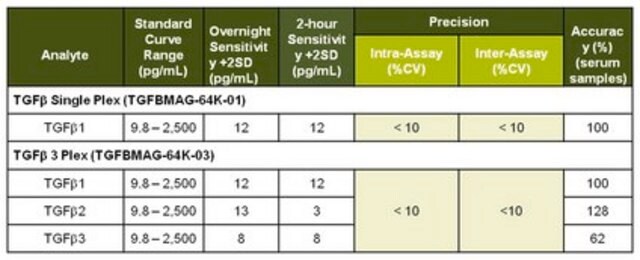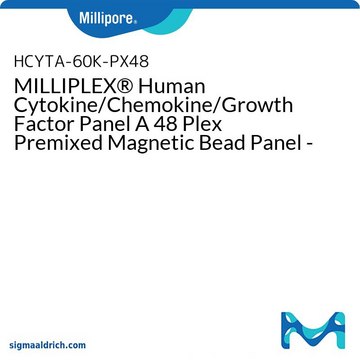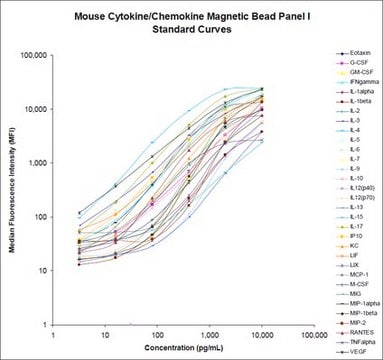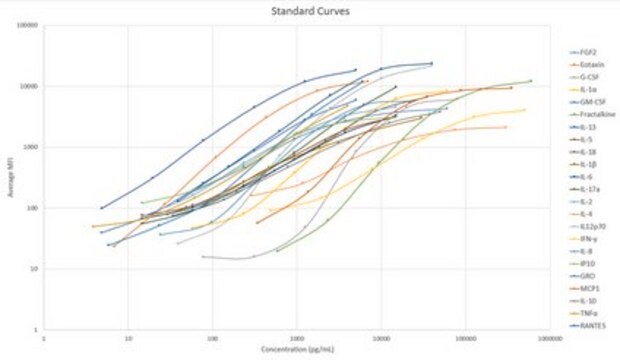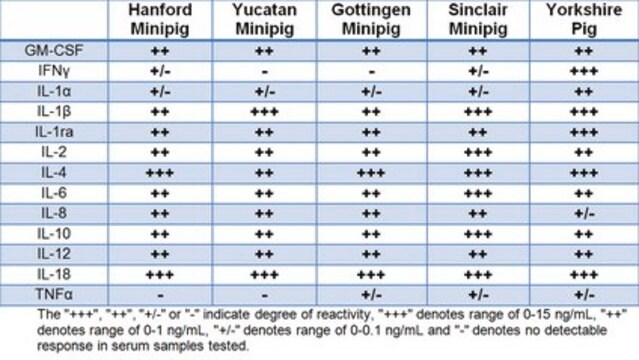TGFBMAG-64K-03
MILLIPLEX® TGFß Magnetic Bead 3 Plex Kit - Immunology Multiplex Assay
for quantification of TGFß1, TGFß2 and TGFß3 in multiple species
Synonym(s):
3 Plex TGFß Assay, TGFß Magnetic Bead Kit
About This Item
Recommended Products
Quality Level
species reactivity
horse, human, nonhuman primates, feline, pig, mouse, rat, canine
manufacturer/tradename
Milliplex®
assay range
accuracy: 62-128%
sensitivity: 8-12 pg/mL
standard curve range: 9.8-2,500 pg/mL
technique(s)
multiplexing: suitable
compatibility
configured for Premixed
detection method
fluorometric (Luminex xMAP)
shipped in
wet ice
General description
The MILLIPLEX® TGFβ 1, 2 and 3 Panel is a 3-plex kit to be used for the simultaneous quantification of the following analytes in serum, plasma and cell/tissue culture samples: TGFβ1, TGFβ2, TGFβ3. The Luminex® xMAP® platform uses a magnetic bead immunoassay format for ideal speed and sensitivity to quantitate multiple analytes simultaneously, dramatically improving productivity while conserving valuable sample volume.
Panel Type: Cytokines/Chemokines
Application
- Analytes: TGF-β1, TGF-β2, TGF-β3
- Recommended Species: In addition to human, TGF-β1, TGF-β2, TGF-β3 can be detected in the serum of the following species: mouse, rat, mini pig, hamster, guinea pig, rhesus monkey and cynomolgus monkey samples. Additionally, TGF-β1 and TGF-β2 can be detected in the serum of horse, rabbit and canine. However, the exact amount of cross reactivity has not been determined.
- NOTE: This assay requires a sample acidification treatment using the provided reagents and protocol.
- Recommended Sample Types: Serum, plasma, cell/tissue culture supernatants and lysates
- Recommended Sample Dilution: 25 μL per well of a 1:30 dilution after acidification treatment of serum and plasma samples; cell/tissue culture samples may require dilution prior to acidification treatment (see protocol for details).
- Assay Run Time: Overnight (16-18 hours) at 2-8°C or alternatively, 2 hours at room temperature (20-25°C).
- Research Category: Inflammation & Immunology
- Research Subcategory: Cardiovascular Disease, Chronic Inflammatory Disease, Immune Disorders, Inflammatory Disease, Rheumatoid Arthritis
Legal Information
Signal Word
Danger
Hazard Statements
Precautionary Statements
Hazard Classifications
Aquatic Chronic 2 - Eye Dam. 1 - Met. Corr. 1 - Skin Corr. 1A - Skin Sens. 1
Storage Class Code
8A - Combustible corrosive hazardous materials
WGK
WGK 3
Certificates of Analysis (COA)
Search for Certificates of Analysis (COA) by entering the products Lot/Batch Number. Lot and Batch Numbers can be found on a product’s label following the words ‘Lot’ or ‘Batch’.
Already Own This Product?
Find documentation for the products that you have recently purchased in the Document Library.
Related Content
Immunology multiplex assays, like MILLIPLEX® assays, allow researchers to investigate more immune biomarkers simultaneously, saving time and resources. This is especially critical to immunology research, where numerous analytes play a role in different pathways.
Learn how immunoassays are used in cosmetics and personal care research to discover potential harmful effects of cosmetics products, and assess markers of inflammation, sensitization, aging, and tissue regeneration among others.
Uncover tips and tricks to multiplexing in this guide from the experts. Learn how you can enhance the power of your research with MILLIPLEX® multiplexing, including industry guidance for immunoassays, multiplexing tips, one-day MILLIPLEX® multiplex assays for limited lab time, and more.
Our team of scientists has experience in all areas of research including Life Science, Material Science, Chemical Synthesis, Chromatography, Analytical and many others.
Contact Technical Service